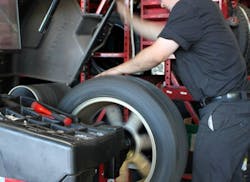This MTD exclusive was provided by Dennis McCarron, author of MTD's monthly Business Insights column and a partner at Cardinal Brokers, one of the leading brokers in the tire and automotive industry (www.cardinalbrokers.com).
In the tire and auto service industry, profit margins are relatively small and business is still highly driven by on-demand services. That means one day can be busy and the next day can be slow.
Most shops only schedule a handful of jobs a day and try to manage the chaos of 12 to 18 surprise customers a day who may only need a basic service or may end up being a very large service ticket.
This environment creates a very unpredictable payroll, especially if many people are hourly or salary. This causes most shops to favor some form of variable, productivity-based compensation for their people who work on vehicles.
Here are some basic steps to implement a tracking system of productivity and the positives and negatives that usually go along with tracking employees’ progress:
1. Set a baseline. Every shop needs to start somewhere. For technicians already on a productivity-based pay program, simply track the hours they clock in for the week and track the number of billable hours they produce. Take the billable hours and divide by clock hours. This equals the technician’s productivity rate. A tech with more billable hours than clock hours will have a plus-100% productivity. A tech with more clock hours will be below 100%. Track this ratio individually and as a group for several weeks. Find patterns and after a few weeks, average the numbers individually and as a group. This will become your baseline.
2.Set goals. Setting goals provides a future state in which your overall company - and hopefully your employees - want to be in. This is not a time to criticize. It’s a time to lead and to listen. At this point, we haven’t done any analysis of the data yet. In my experience, an aftermarket service shop - as a collective - should be at minimum 80% productive, with the lowest- performing technician averaging 70% productivity. Set goals higher than baseline for both individuals and your team.
3. Remove obstacles. As a leader, you must go out into the shop and observe. There are thousands of reasons why a tech’s productivity may be low. They may be good mechanics, but not good at multitasking. Maybe the tech multitasks too quickly and creates comebacks or the work isn’t being delegated properly, the parts take too long to arrive, vehicle inspections aren’t being done prior to original requested work, etc. Go out into your service bays, observe and talk to your people. Listen to learn - not to respond. Then remove the obstacles.
4. Provide rewards to keep your staff motivated and focused. Every productivity-based system needs rewards to keep employees motivated. Those rewards can’t be “set it and forget it,” nor can they be externally based-only. External rewards need to change minimally every quarter. Keep it simple, but don’t let it get stale. Internal rewards - the true motivational factor - are the accolades you provide for a job well done.
No system is perfect. If it were, there would be no variety, no challenges and everything would be boring. Profitability also would plummet.
The cons of tracking productivity are largely two-fold. First, employees instinctively know that pressure is coming. Pressure often creates stress, which hurts productivity. Make sure to include your employees in as many steps and solutions as possible. They are on the front lines and know best, but usually will prioritize their comfort over tension. But tension is good. Tension creates productivity.
The second thing any owner or leader needs to fight is using productivity as a weapon. Nothing kills morale more quickly than introducing a new tool and weaponizing it. Tracking productivity needs to be used to solve problems - not as a blunt force object. If you are tracking productivity and not getting the results you want, go out, observe and listen.
Yes, sometimes the solution to low productivity is to release an employee. Maybe there’s not enough work to go around. Maybe after trying for months, it’s just not clicking. But many times, the solution is education - for the owner, the tech or both.
The pros of tracking productivity are also mainly two-fold. First, it means more opportunity for you and your employees to earn money. If it only helps one but not the other, you have a very bad program.
Second, tracking productivity should allow the core values of your company to shine through. Do you value correct diagnosis over speed? Do you hold employees accountable for labor mistakes and seek reimbursement from parts houses for parts failures?
In the end, by following a few rules, tracking productivity at a simple, fast and easy level will be very helpful to your dealership and will provide an opportunity for your employees to earn more and not be locked to a clock.
Dennis McCarron is a partner at Cardinal Brokers, one of the leading brokers in the tire and automotive industry (www.cardinalbrokers.com). To contact McCarron, email him at [email protected].




